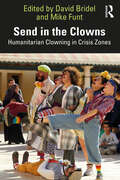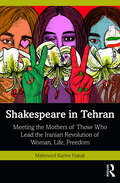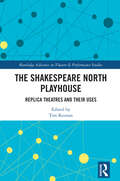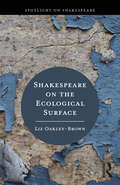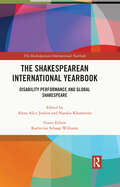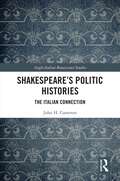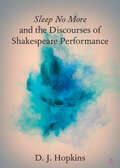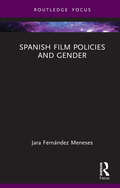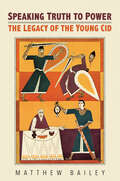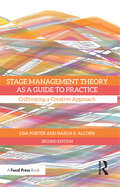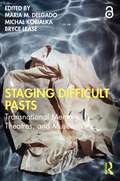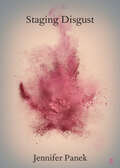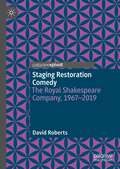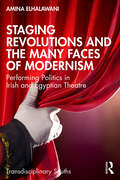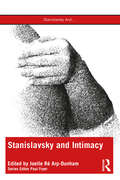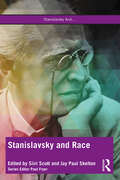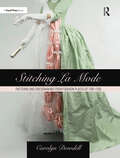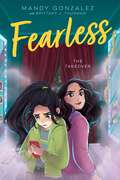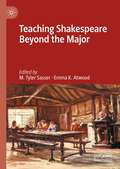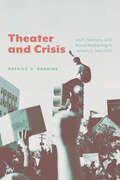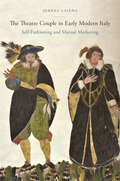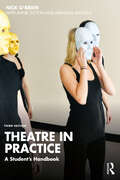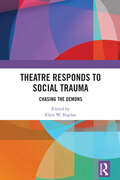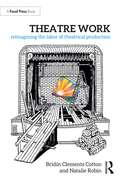- Table View
- List View
Send in the Clowns: Humanitarian Clowning in Crisis Zones
by David Bridel Mike FuntSend in the Clowns presents interviews with twenty-four pioneering humanitarian and activist clowns and thought leaders working in hospitals, refugee camps, orphanages and war zones, and at the sites of street protests and locations of social unrest across the world.This book is built around interviews with some of the world’s leading practitioners of clowning for change, justice, and health outside of the entertainment mainstream, featuring artists and organizations including Patch Adams (US), the Dream Doctors Project (Israel), Clown Me In (Lebanon), and Doutores da Alegria (Brazil). Situating the topic in relation to indigenous and ritual clowning, investigating the various functions of the clown in early societies, and centering the discourse around interviews with key practitioners, the book explores a wide range of clown applications across the globe. This includes the special significance of the clown archetype in socially, politically, and culturally challenging situations, the successes and challenges of the art activists who are at the forefront of this movement, and the modern humanitarian clown’s relationship to original forms of clowning that can be traced back through history.This is a vital resource for anyone studying, teaching, or practicing clown work in applied contexts, from health care to conflict resolution.
Shakespeare in Tehran: Meeting the Mothers of Those Who Lead the Iranian Revolution of Woman, Life, Freedom
by Mahmood Karimi HakakShakespeare in Tehran is a personal history of Iran through the eyes of an award-winning Iranian American artist. Drawing on parallels between life and the stage, it uses A Midsummer Night’s Dream as a roadmap to explore social, political, economic, and cultural aspects of Iran before and after the revolution of 1979. Through first-person accounts, interspersed with emotional reflections of the universal human experience, it delves into the historical and sociological context of a divided country. Storytelling, flashbacks, and flashforwards paint an intimate picture of public life in Iran in a time of uncertainty. Accessible, engaging, and nuanced, this volume will be of interest to scholars and researchers of politics, history, theater and performance studies, and West Asian studies.
The Shakespeare North Playhouse: Replica Theatres and Their Uses (ISSN)
by Tim KeenanThis collection celebrates the opening of the Shakespeare North Playhouse (SNP). After discussion of its genesis and development by four people pivotal to its progress at different stages of the project, this book explores different aspects of the SNP’s purpose and functions across three broad categories: buildings and spaces, practices and performance, and community arts and education. Various chapters offer answers to fundamental questions about replica theatres, including: Why do we build them? What do they do? How do we use them? In the course of these discussions, the purposes, potential, and programming of the SNP are discussed in relation to other Globe-type replicas in the UK and beyond. Contributors to this collection analyse key academic and practice-based concerns within their fields of expertise connected to the use (and misuse) of replica theatres to suggest the ways in which they can be used to drive research and practice in contemporary Shakespearean performance, connect with young people, and serve local communities.This book will appeal to academics, students, and practitioners interested in historical and contemporary approaches to Shakespeare in the fields covered. It should also appeal to general readers with an interest in the topics, particularly in Merseyside and the North-West region.
Shakespeare on the Ecological Surface (Spotlight on Shakespeare)
by Liz Oakley-BrownShakespeare on the Ecological Surface uses the concept of the ‘surface’ to examine the relationship between contemporary performance and ecocriticism. Each section looks, in turn, at the 'surfaces' of slick, smoke, sky, steam, soil, slime, snail, silk, skin and stage to build connections between ecocriticism, activism, critical theory, Shakespeare and performance. While the word ‘surface’ was never used in Shakespeare’s works, Liz Oakley-Brown shows how thinking about Shakespearean surfaces helps readers explore the politics of Elizabethan and Jacobean culture. She also draws surprising parallels with our current political and ecological concerns. The book explores how Shakespeare uses ecological surfaces to help understand other types of surfaces in his plays and poems: characters’ public-facing selves; contact zones between characters and the natural world; surfaces upon which words are written; and physical surfaces upon which plays are staged. This book will be an illuminating read for anyone studying Shakespeare, early modern culture, ecocriticism, performance and activism.
The Shakespearean International Yearbook: Disability Performance and Global Shakespeare (The Shakespearean International Yearbook)
by Alexa Alice Joubin Natalia Khomenko Katherine Schaap WilliamsThe Shakespearean International Yearbook surveys the present state of Shakespeare studies in global contexts, addressing issues that are fundamental to our interpretive encounter with Shakespeare’s work and his time. Contributions are solicited from scholars across the field and from both hemispheres of the globe who represent diverse career stages and linguistic traditions. Both new and ongoing trends are examined in comparative contexts, and emerging voices in different cultural contexts are featured alongside established scholarship. Each volume features a collection of articles that focus on a theme curated by a specialist Guest Editor, along with coverage of the current state of the field in other aspects. An essential reference tool for scholars of early modern literature and culture, this annual publication captures, from year to year, current and developing thought in global Shakespeare scholarship and performance practice worldwide.
Shakespeare’s Politic Histories: The Italian Connection (Anglo-Italian Renaissance Studies)
by John H. CameronThis book argues that Shakespeare's first tetralogy is informed by the Italian ‘politic histories’ of the early modern period, those works of history, inspired by the Roman historian Tacitus, that sought to explore the machinations of power politics in governance and in the shaping of historical events; that a close reading of these Italian ‘politic histories’ will greatly aid our understanding of the ‘politic’ qualities dramatized in Shakespeare’s early English History plays; that the writings of Niccolò Machiavelli in particular will likewise aid to such understanding; that these ‘politic histories’ were available (in a variety of forms) to many English early modern writers, Shakespeare included, and are thus helpful as grounds for political and strategic analogy and for informing our reading of Shakespeare's politic histories. While a reading of the Italian ‘politic’ historians can aid in our understanding of Shakespeare’s achievement, we should regard the English History plays as ‘politic histories’ in their own right, i.e. as dramatized versions of precisely the same kinds of ‘politic’ historical writing, with its emphasis on ragion di Stato or raison d’état. This emphasis on what the Elizabethans called ‘stratagems’ suggests new ways to read the plays and to interpret the motivation and action of its characters, ways that challenge some of our more established reading of the plays’ ‘Machiavellian’ characters (particularly Richard III) and suggest far greater strategic acumen on the part of previously overlooked characters (particularly Buckingham and Stanley), providing new ways to read the Shakespeare's politic histories and to better appreciate their Italian connection.
Sleep No More and the Discourses of Shakespeare Performance (Elements in Shakespeare Performance)
by null D. J. HopkinsThis Element focuses on Sleep No More, theatre adaptation of Macbeth produced by the British company Punchdrunk. This Element frames the Shakespeare adaptation as part of a system of ghostly citationality through which audiences understand the significance of the past in performances today. Hopkins introduces the concept of “uncanny spectatorship” to describe audience practice in Sleep No More and other performance contexts. The Element positions experiences like Sleep No More as forms of critical inquiry, and, despite its seemingly analog format, Sleep No More is discussed as a valuable site for media research. Ultimately, Sleep No More and the Discourses of Shakespeare Performance Sleep No More offers an opportunity to explore a set of concepts that are significant to the subject of Shakespeare Performance and to consider the ways in which audiences interact with bodies, spaces, text, and media.
Spanish Film Policies and Gender (Routledge Focus on Media and Cultural Studies)
by Jara Fernández MenesesThis book provides a comprehensive cultural and historical account of the key film policies put into place by the Spanish state between 1980 and 2010 through a gendered lens, framing these policies within the wider context of European film legislation.Departing from the belief that there is no such thing as an objective and value-neutral approach to policy analysis because our society is organised around gender, this volume builds upon Pierre Bourdieu’s theory of field to propose that film policies do not emerge in a vacuum because they respond to different demands from those agents involved in the field of the Spanish cinema. By so doing, it critically assesses how these policies have come into being, by whom, in response to what interests, how they have shaped the Spanish film industry, and how far and in what ways they have tackled gender inequality in the Spanish film industry.This book will be of great interest to scholars and students of Spanish cinema, gender studies, film industry studies, film policy, and feminist film studies.
Sparkles, No Sparkles
by Shannon McNeillAdorable animals go for a glittering night at the theater in this hilarious picture book, a perfect read-aloud tale for very young readers.A frog has no sparkle.A poodle has no sparkle.A pigeon has no sparkle.Not to worry! A cape has sparkle, a crown has sparkle and boots have sparkle.Some wily animals decide to hit the stage, leaving the actors without costumes. After the animals get their moment in the spotlight, chaos ensues . . . but luckily there are some chicks with sparkle to save the day.
Speaking Truth to Power: The Legacy of the Young Cid (Toronto Iberic #86)
by Matthew BaileyEmerging from a richly diverse oral narrative tradition, the heroic tale of the young Cid appears in multiple textual manifestations. From its first appearance circa 1300, the dynamic narrative of the legendary deeds of this young Castilian warrior eclipses the uninspired, matter-of-fact narration of the reign of Fernando I into which it is incorporated. In its analysis of the Mocedades de Rodrigo, the epic poem of Cid’s youth, Speaking Truth to Power identifies the narrative cohesion and the aesthetic principles that elevated the story of the young Cid to its place of prominence among the epic narratives of medieval Spain. Examining the evolution of the narrative through various textual versions, Matthew Bailey highlights the permutations that propelled the young Cid’s unparalleled popularity. The book traces this vibrant narrative tradition from its earliest manifestation in the aftermath of Charlemagne’s imperial mission in Spain to the early modern drama of Guillén de Castro. It convincingly discerns the leadership qualities and the social impact of its legendary protagonists, from their manifestation in the Latin chronicles of early Iberia through the Renaissance, incorporating a wealth of previous scholarship in its innovative findings. Speaking Truth to Power provides readers with a heightened appreciation for the vibrancy of the poetic tradition that lives beyond the texts we study, the oral narratives that are continually refashioned for new audiences and contexts.
Stage Management Theory as a Guide to Practice: Cultivating a Creative Approach
by Lisa Porter Narda E. AlcornStage Management Theory as a Guide to Practice, Second Edition offers theory and methodology for developing a unique and inclusive stage management style, preparing stage managers to develop an adaptive approach for the vast and varied scope of the production process, forge their own path, and respond to the present moment with care and creativity. This book provides tactile strategies, enabling stage managers to navigate different groups of collaborators, venues, and projects. Experiential stories based on extensive experience with world-renowned artists exemplify the practices and provide frameworks for self-reflection, synthesis, and engagement with theory-guided practice. This book empowers stage managers to guide any collaborative project to fruition by incorporating the "How You" with the "How To." This second edition has been expanded, and includes new experiential stories and a new chapter focused on inclusive processes that can be applied from pre-production through closing, as well as the full text of the HowlRound Theatre essay We Commit to Anti-Racist Stage Management Education. Exploring topics such as group dynamics, ethics, culture, and strategic communication, Stage Management Theory as a Guide to Practice is an essential tool for advanced stage management students, educators, and professionals.
Staging Difficult Pasts: Transnational Memory, Theatres, and Museums
by Maria M. Delgado Michal Kobialka Bryce LeaseThis collection of original essays brings together museum, theatre, and performance case studies with a focus on their distinctive and overlapping modes of producing memory for transnational audiences. Whether this is through narrative, object, embodied encounter or a combination of the three, this volume considers distinctions and interactions between memory and history specifically through the lenses of theatre and performance studies, visual culture, and museum and curator studies. This book is underpinned by three areas of research enquiry: How are contemporary theatre makers and museum curators staging historical narratives of difficult pasts? How might comparisons between theatre and museum practices offer new insights into the role objects play in generating and representing difficult pasts? What points of overlap, comparison, and contrast among these constructions of history and memory of authoritarianism, slavery, colonialism, genocide, armed conflict, fascism, and communism might offer an expanded understanding of difficult pasts in these transnational cultural contexts? This collection is designed for any scholar of its central disciplines, as well as for those interested in cultural geography, memory studies, and postcolonial theory. The Open Access version of this book, available at http://www.taylorfrancis.com, has been made available under a Creative Commons Attribution-NoDerivatives (CC-BY-ND) 4.0 license.
Staging Disgust: Rape, Shame, and Performance in Shakespeare and Middleton (Elements in Shakespeare Performance)
by null Jennifer PanekThis Element turns to the stage to ask a simple question about gender and affect: what causes the shame of the early modern rape victim? Beneath honour codes and problematic assumptions about consent, the answer lies in affect, disgust. It explores both the textual "performance" of affect, how literary language works to evoke emotions and the ways disgust can work in theatrical performance. Here Shakespeare's poem The Rape of Lucrece is the classic paradigm of sexual pollution and shame, where disgust's irrational logic of contamination leaves the raped wife in a permanent state of uncleanness that spreads from body to soul. Staging Disgust offers alternatives to this depressing trajectory: Middleton's Women Beware Women and Shakespeare's Titus Andronicus perform disgust with a difference, deploying the audience's revulsion to challenge the assumption that a raped woman should “naturally” feel intolerable shame.
Staging Restoration Comedy: The Royal Shakespeare Company, 1967-2019
by David RobertsSince its 1967 production of Vanbrugh’s The Relapse, the Royal Shakespeare Company has been the world’s leading producer of Restoration Comedies. This book is the first to document and critique the company’s history of engagement with that repertoire. It reviews the spaces in which productions have been performed, design principles, casting, voicing, textual adaptation, musical direction, actor perspectives, and the problems of how to confront, adopt or depart from received notions of Restoration style. It goes on to posit that, for all the RSC’s explorations of Restoration Comedy, the company has maintained the repertoire as a fringe interest played out in niche spaces, while recycling many of the assumptions it claims to challenge, and that what is needed is the writer-led intervention seen in RSC and National Theatre adaptations of French drama from the same period. Only then can Restoration Comedy begin to engage wider audiences in new sites of political, historical andcultural meaning.
Staging Revolutions and the Many Faces of Modernism: Performing Politics in Irish and Egyptian Theatre (Transdisciplinary Souths)
by Amina ElHalawaniThe book explores how theatre, with its performative capacity, has the power to engage with and affect the politics of its day. It sets the stage for the reader to discover the revolutionary traditions of Egyptian and Irish theatre, very distinct in their histories and cultures, and understand their enduring relevance in today’s world. The volume takes Ireland as a case study of the interplay between cultural nationalism and politically engaged theatre and compares it to the role of the theatre in Egypt during its Golden era in the 1960s.Through a selection of Egyptian plays by Tawfiq al-Hakim, Mikhail Roman, Yusuf Idris, and Salah Abdul-Saboor, alongside Irish plays by Brian Friel, Frank McGuinness, Christina Reid, and Samuel Beckett, it maps the political aesthetics of unsteady times and seemingly disparate places to reflect on the dynamics of revolt as a staged act in and of itself. Further, the book examines how playwrights from both nations have engaged with theatre as a medium, focusing on how their contemplations, hesitations, frustrations, and protest have been translated onto the stage in their various plays, and comprehends the transformative role the theatre has always played in politics in shaping history across time and space.Bridging together discussions on transnational modernisms with nuanced cultural histories of protest, this critical work will be of great interest to scholars and researchers of literary studies, identity politics, cultural studies, theatre and performance studies, and political studies.
Stanislavsky and Intimacy (Stanislavsky And...)
by Arp-Dunham, Joelle RéStanislavsky and Intimacy is the first academic edited book with a focus on how intimacy protocols, choreography, and theories intersect with the broad practices of Konstantin Stanislavsky’s ‘system’. As the basis for most Western theatre and film acting, Stanislavsky’s system centers on truthful performances. Intimacy direction and choreography insists on not only a culture of consent, but also specific, repeatable choreography for all staged intimate moments. These two practices have often been placed as diametric opposites, but this book seeks to dispel this argument. Each chapter discusses specific Stanislavskian principles and practices as they relate to staged sexually intimate moments, also opening the conversation to the broader themes and practices of other kinds of intimacy within the acting field. Stanislavsky And... is a series of multi-perspectival collections that bring the enduring legacy of Stanislavskian actor training into the spotlight of contemporary performance culture, making them ideal for students, teachers, and scholars of acting, actor training, and directing.
Stanislavsky and Race: Questioning the “System” in the 21st Century (Stanislavsky And...)
by Siiri Scott Paul SkeltonStanislavsky and Race is the first book to explore the role that Konstantin Stanislavsky’s “system” and its legacies can play in building, troubling and illuminating today’s anti-racist theatre practices. This collection of essays from leading figures in the field of actor training stands not only as a resource for a new area of academic enquiry, but also for students, actors, directors, teachers and academics who are engaged in making inclusive contemporary theatre. In seeking to dismantle the dogma that surrounds much actor training and replace it with a culturally competent approach that will benefit our entire community, the “system” is approached from a range of perspectives featuring the research, reflections and provocations of 20 different international artists interrogating Stanislavsky’s approach through the lens of race, place and identity. Stanislavsky and … is a series of multi-perspectival collections that bring the enduring legacy of Stanislavskian actor training into the spotlight of contemporary performance culture, making them ideal for students, teachers and scholars of acting, actor training and directing.
Stitching La Mode: Patterns and Dressmaking from Fashion Plates of 1785-1795
by Carolyn DowdellStitching La Mode: Patterns and Dressmaking from Fashion Plates of 1785-1795 brings to life women’s unique and extravagant fashions of 1785-1795 in a beautifully illustrated and accessible way. The book consists of scaled patterns directly based on original French, German and English fashion plates drafted according to period-accurate shapes. The patterns encompass the full look presented in each fashion plate from garments to accessories. These are accompanied by a color image of the corresponding fashion plate, straightforward, illustrated directions for recreating the outfits, information on the material used and modelled reproductions of each plate to demonstrate what they would look like in "real life". The book focuses on unique styles often seen in fashion plates but rarely – if ever – patterned before, making this a fresh and exciting yet historically accurate take on late eighteenth-century fashion. Stitching La Mode significantly expands the understanding of transitional fashions from the late eighteenth century with concrete, physical examples of styles, perfectly suited for costume technicians and makers, costume historians and hobby costumers and re-enactors.
The Takeover (Fearless Series #4)
by Mandy GonzalezBetter Nate than Ever meets Love Sugar Magic in this fourth and final novel in the Fearless middle grade series from Hamilton and Broadway star Mandy Gonzalez about a young thespian and emerging influencer whose social media gets hacked.Twelve-year-old April DaSilva loves performing—and connecting with fans on her social media accounts. Thanks to her role in the hit Broadway show Our Time, she is close to reaching a huge follower milestone. In celebration, she&’s hosting a contest: three lucky followers will win a special backstage tour and tickets to the show. April feels on top of the world, but her brother isn&’t so thrilled about her attention always being glued to a screen. His warnings don&’t bother April. What&’s wrong with wanting more followers and likes? When meet and greet day arrives, the Squad helps make the event special. All goes without a hitch until April attempts to log into her social media…it&’s gone. Her previous posts have been erased, and a new one that April didn&’t make pops up. It&’s even worse than she thought…she&’s been hacked. The Squad tries to uncover the culprit while April becomes a puppet of her stolen account—desperately trying to keep up with the public appearances promised in her name until she can reclaim ownership of the online presence she&’s worked so hard for. But she suddenly has much more to worry about when it&’s announced that the entire Squad has outgrown their roles in Our Time and may soon be replaced…
Teaching Shakespeare Beyond the Major
by M. Tyler Sasser Emma K. AtwoodThis edited collection considers the task of teaching Shakespeare in general education college courses, a task which is often considered obligatory, perfunctory, and ancillary to a professor’s primary goals of research and upper-level teaching. The contributors apply a variety of pedagogical strategies for teaching general education students who are often freshmen or sophomores, non-majors, and/or non-traditional students. Offering instructors practical classroom approaches to Shakespeare’s language, performance, and critical theory, the essays in this collection explicitly address the unique pedagogical situations of today’s general education college classroom.
Theater and Crisis: Myth, Memory, and Racial Reckoning in America, 1964-2020
by Patrice D. RankineRacial reckoning was a recurrent theme throughout the summer of 2020, a response to George Floyd’s murder and the unprecedented impact of COVID on marginalized groups. Theater and Crisis proposes a literary and theatrical study of how Floyd's killing could possibly happen in the aftermath of the Civil Rights era, and in the supposedly post-racial era following the election of Barack Obama. In the days and months following Floyd's death, there were nightly protests in streets across the United States and broader world. At the same time, theater performances were forced to shift online to video conferencing platforms and to find new ways to engage audiences. In each case, groups made shared meaning through storytelling and narrative, a liberatory process of myth-making and reverence that author Patrice D. Rankine calls “epiphanic encoding.” Rather than approaching the problem of racial reckoning through history, where periodization and progress are dominant narratives, Theater and Crisis argues that myth and memory allow for better theorization about recurring events from the past, their haunting, and what these apparent ghosts ask of us. Building on the study of myth as active, processual storytelling, Rankine acknowledges that it grounds and orients groups toward significant events. Theater and Crisis aligns narratives about Emmett Till, Trayvon Martin, and George Floyd, among others, with ancient, mythic figures such as Christ, Dionysus, Oedipus, and Moses. As living and verbal visitations, these stories performed on stage encode the past through their epiphanies in the present, urging audiences toward shared meaning. Rankine traces the cyclical hauntings of race through the refiguring of mythic stories across the past 75 years in the plays of James Baldwin, Ntozake Shange, Antoinette Nwandu, and many more, and in response to flashpoints in US racial history, such as the 1955 lynching of Emmett Till, the upheavals of the 1960s and 1970s, the wars on drugs and crime, and the continued violence against and disenfranchisement of Black people into the twenty-first century. Theater and Crisis explores the appearance of myth on the American stage and showcases the ongoing response by the theatrical establishment to transform the stage into a space for racial reckoning. This timely book is essential reading for scholars of theater studies, classics, and American studies.
The Theatre Couple in Early Modern Italy: Self-Fashioning and Mutual Marketing (Performing Celebrity)
by Serena LaienaWho were the first celebrity couples? How was their success forged? Which forces influenced their self-fashioning and marketing strategies? These questions are at the core of this study, which looks at the birth of a phenomenon, that of the couple in show business, with a focus on the promotional strategies devised by two professional performers: Giovan Battista Andreini (1576–1654) and Virginia Ramponi (1583–ca.1631). This book examines their artistic path – a deliberately crafted and mutually beneficial joint career – and links it to the historical, social, and cultural context of post-Tridentine Italy. Rooted in a broad research field, encompassing theatre history, Italian studies, celebrity studies, gender studies, and performance studies, The Theatre Couple in Early Modern Italy revises the conventional view of the Italian diva, investigates the deployment of Catholic devotion as a marketing tool, and argues for the importance of the couple system in the history of Commedia dell’Arte, a system that continues to shape celebrity today.
Theatre in Practice: A Student's Handbook
by Nick O'BrienTheatre in Practice, third edition, is an accessible and wide-ranging exploration of the central practices and key practitioners covered on the various syllabi at A level, IB, and at undergraduate level.Exploring Stanislavski, Brecht, Artaud, Lecoq, Berkoff, Bogart, Mitchell and Craig, as well as work from innovative theatre companies such as Tamasha, Sh!T Theatre, Complicite, Gecko and The Paper Birds, it combines an informal, unpretentious tone with a wealth of practical exercises. Revised and updated to include some of the latest practices in theatre, this new edition offers a step-by-step approach to developing key skills such as devising, improvising, rehearsing mono/duologues and directing plays.New for this edition are chapters from Nick O'Brien and Mikhaela Mahony on key female and global majority practitioners; a chapter offering a unique insight into the acting practice of award-winning actress Indira Varma; and updated information throughout.Written by specialists with extensive experience at post-16 and undergraduate level, Theatre in Practice is a thorough and imaginative resource that speaks directly to students and teachers. This book offers students a range of exercises to experience and explore key practitioners enabling them to understand theatre how it should be understood: through practice.
Theatre Responds to Social Trauma: Chasing the Demons (Routledge Series in Equity, Diversity, and Inclusion in Theatre and Performance)
by Ellen W. KaplanThis book is a collection of chapters by playwrights, directors, devisers, scholars, and educators whose praxis involves representing, theorizing, and performing social trauma.Chapters explore how psychic catastrophes and ruptures are often embedded in social systems of oppression and forged in zones of conflict within and across national borders. Through multiple lenses and diverse approaches, the authors examine the connections between collective trauma, social identity, and personal struggle. We look at the generational transmission of trauma, socially induced pathologies, and societal re-inscriptions of trauma, from mass incarceration to war-induced psychoses, from gendered violence through racist practices. Collective trauma may shape, protect, and preserve group identity, promoting a sense of cohesion and meaning, even as it shakes individuals through pain. Engaging with communities under significant stress through artistic practice offers a path towards reconstructing the meaning(s) of social trauma, making sense of the past, understanding the present, and re-visioning the future.The chapters combine theoretical and practical work, exploring the conceptual foundations and the artists’ processes as they interrogate the intersections of personal grief and communal mourning, through drama, poetry, and embodied performance.
Theatre Work: Reimagining the Labor of Theatrical Production
by Brídín Clements Cotton Natalie RobinTheatre Work: Reimagining the Labor of Theatrical Production investigates both the history and current realities of life and work in professional theatrical production in the United States and explores labor practices that are equitable, accessible, and sustainable.In this book, Brídín Clements Cotton and Natalie Robin investigate the question of artmaking, specifically theatrical production, as work. When the art is the work, how do employers navigate the balance between creative freedom and these equitable, accessible, and sustainable personnel processes? Do theatrical production operations value the worker? Through data analyses, worker narratives, and analogues to the evolving gig economy, Theatre Work questions everything about theatrical production work – including our shared history, ways of operating, and assumptions about how theatre is made – and considers what might happen if the American Theatre was reborn in an entirely new form.Written for members of the theatrical production workplace, leaders of theatrical institutions and productions, labor organizers, and industry union leaders, Theatre Work: Reimagining the Labor of Theatrical Production speaks to the ways that employers and workers can reimagine how we work.
